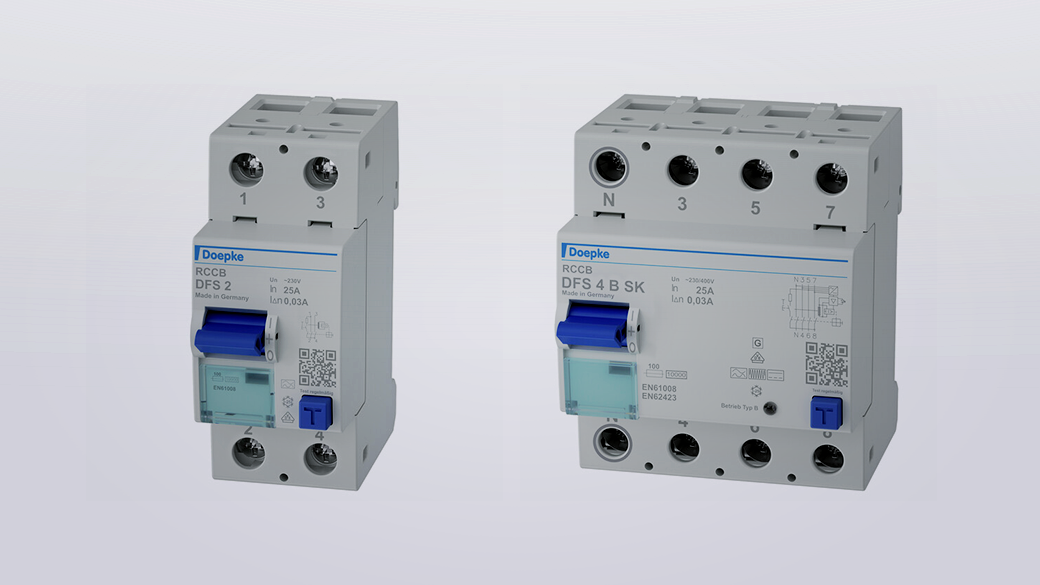Residual Current Circuit Breaker (RCCBs)
Overview
Doepke ผลิตอุปกรณ์ตัดวงจรไฟฟ้า เนื่องจากกระแสไฟรั่ว เบรกเกอร์กันดูด type A ได้ มอก 2545-2560 ชนิด 2 โพล 16A, 25A, 40A, 63A, 80A และชนิด 4 โพล 16A, 25A, 40A, 63A

Product detail
อุปกรณ์ตัดวงจรไฟฟ้า เนื่องจากกระแสไฟรั่ว (เบรกเกอร์กันดูด) มีหลายชนิด เช่น
- Type A switches are sensitive to pulsating and alternating currents. This function is independent of the mains voltage.
- Type B switches are AC-DC sensitive at frequencies of 0 Hz (smooth residual currents) to 150 kHz. They have increased resistance to surge currents and lightning.
- Type B+ residual current circuit-breakers detect smooth DC residual currents and all other residual currents at frequencies up to 20,000 Hz. The operating voltage required for this is taken from the mains supply. Correct power supply is ensured when the voltage between the mains conductors is ≥ 50 V. Pulsating and AC residual currents are detected independent of the mains voltage.
- Type F switches are mixed frequency sensitive. They protect against pulsating and AC residual currents as well as residual currents with mixed frequencies that differ from 50 Hz independent of the mains voltage.
Function
Residual current circuit-breakers (RCCBs) are components for implementing protective measure “Automatic disconnection of the powersupply” as per VDE 0100 part 410 or corresponding international installation regulations. Series DFS devices are compact two or fourpole residual current circuit-breakers. In the standard design, they only take up four module width units of space. Although DFS devices for AC and pulsating DC residual currents are actually designed for three-phase networks, they can also be used in single-phase networks.
However, in addition to these, special variants are also available for single or three-phase operation in the form of the AC/DC sensitive designs (type B, type B+). In spite of the compact dimensions, a number of different tripping currents and characteristics are available at rated currents, depending on the design, up to 125 A. They also have large two-tier terminals for large conductor cross-sections, a practical multi-functional switch toggle and can be provided with labels using free-of-charge software. Type A residual current circuitbreakers are sensitive to pulsating and alternating currents. This function is independent of the mains voltage. Devices in the standard design are intended for monitoring circuits with a rated voltage of 230, 400 V, V and a rated frequency of 50 Hz.
Features
tripping not dependent on mains and auxiliary voltage, sensitive to AC residual currents and pulsating DC residual currents (type A) , compact design for all rated currents, high short-circuit resistance, double-sided two-tier terminals for large conductor cross-section andbusbar, switch position indicator, viewing window for labels, multifunction switch toggle with three positions: “on”, “off” and “tripped”,
Neutral conductor position left
Applications
Power supplies to residential and purpose-built buildings as well as industrial facilities with TN-S, TT and TN-C-S networks. In IT networks, the residual current circuit-breakers of this series can be set to switch off in the event of a second fault, Excluded is the application in TNC systems and for the protection of installations in which electronic equipment could generate smooth DC currents or residual currents
with frequencies other than 50 Hz. Comprehensive protection is not provided in this case. For these applications we recommend our AC/DC sensitive residual current circuit-breakers (Type B or B+).
Basic circuits for electronic equipment
The following table shows the time curve for the load and fault currents for electronic equipment with various basic circuits, and also specifis the RCD types suitable for comprehensive protection.


